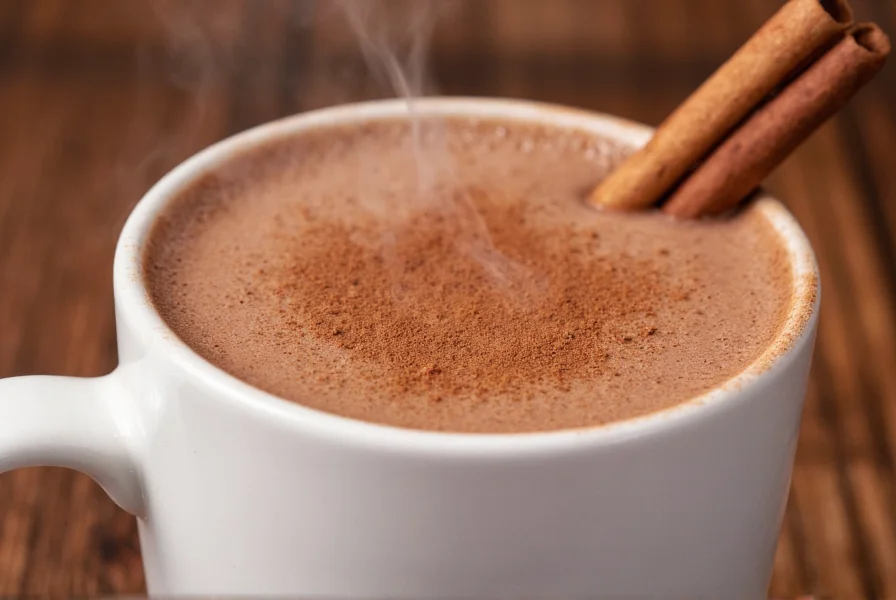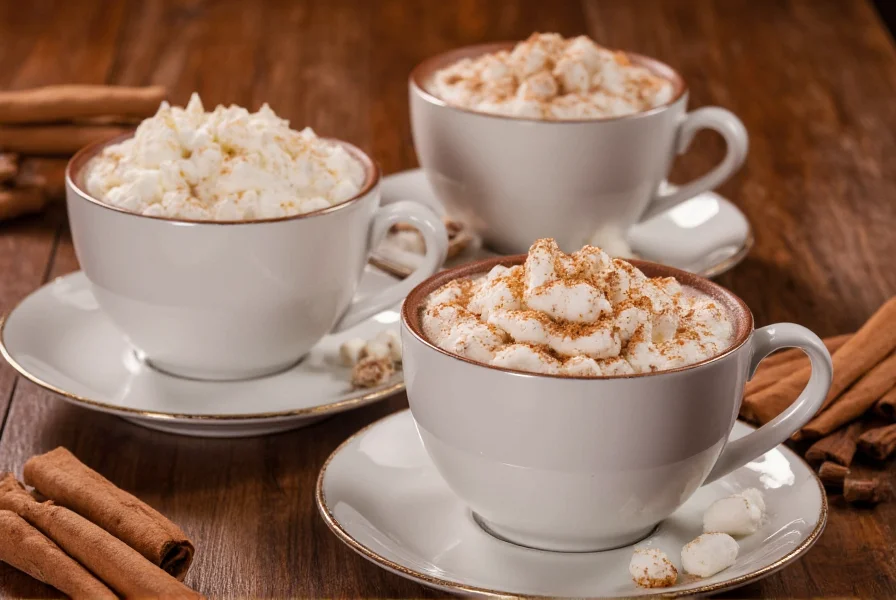There's something magical about the combination of chocolate and cinnamon that transforms a simple beverage into an experience. This beloved pairing dates back to ancient Mesoamerican civilizations, where chocolate was first consumed as a spicy drink rather than the sweet treat we know today. Modern science confirms what ancient cultures intuitively understood—cinnamon and chocolate create a flavor synergy that elevates both ingredients.
The Science Behind the Perfect Pairing
Cinnamon contains cinnamaldehyde, the compound responsible for its distinctive aroma and flavor, which complements chocolate's complex flavor profile containing over 600 chemical compounds. When combined, these ingredients create what food scientists call flavor layering—where neither ingredient overpowers the other but instead creates a more complex, satisfying taste experience.
Research published in the Journal of Food Science shows that the warm, sweet notes of cinnamon can actually enhance our perception of chocolate's richness while reducing the need for added sugar. This makes cinnamon hot chocolate not just delicious, but potentially a smarter choice for those watching their sugar intake.
Historical Evolution of Cinnamon and Chocolate
The fusion of chocolate and cinnamon spans millennia, with documented shifts in preparation and cultural significance. Verified historical developments include:
| Era | Key Development | Archaeological Verification |
|---|---|---|
| 1900-1500 BCE | Olmec civilization processes cacao beans into bitter ceremonial beverages, though without Old World spices like cinnamon (native to Asia) | International Cocoa Organization |
| 600-900 CE | Maya elites consume xocolātl with chili peppers and annatto, but cinnamon remains absent in pre-Columbian Americas | International Cocoa Organization |
| 1528 CE | Spanish explorers introduce European spices to chocolate, with cinnamon becoming standard in Spanish colonial recipes by 1550 | International Cocoa Organization |
| 17th Century | Cinnamon-sweetened chocolate spreads across European aristocracy, documented in Spanish apothecary records as a medicinal tonic | International Cocoa Organization |
Note: Cinnamon's integration occurred post-1492, as the spice was unknown in the pre-Columbian Americas. Its pairing with chocolate represents one of history's earliest global flavor exchanges.
Traditional Preparation Methods
While modern recipes often call for simply adding cinnamon to prepared hot chocolate, authentic preparation involves infusing the milk with cinnamon first. This technique, used in traditional Mexican hot chocolate, allows the fat molecules in milk to better absorb cinnamon's essential oils, creating a more integrated flavor profile.
| Ingredient | Standard Recipe | Rich Variation | Light Version |
|---|---|---|---|
| Milk | 2 cups whole | 1.5 cups whole + 0.5 cup heavy cream | 2 cups unsweetened almond milk |
| Dark Chocolate | 3 oz (70% cocoa) | 4 oz (85% cocoa) | 2.5 oz (60% cocoa) |
| Cinnamon | 1 tsp ground | 1.5 tsp freshly grated | 1 tsp ground |
| Sweetener | 1 tbsp maple syrup | 2 tbsp raw sugar | 1 tsp stevia |
Step-by-Step Preparation Guide
Creating exceptional cinnamon hot chocolate requires attention to detail. Follow these professional techniques for the best results:
- Infuse the milk: Heat milk with cinnamon sticks (or ground cinnamon) over medium-low heat for 5-7 minutes, just below simmering point. This gentle heating extracts maximum flavor without scalding.
- Temper the chocolate: Remove milk from heat, add chopped chocolate, and let sit for 1 minute before stirring. This prevents chocolate from seizing.
- Whisk vigorously: Use a wire whisk in a circular motion to create a slight foam layer, which enhances mouthfeel.
- Rest before serving: Let the mixture sit for 2-3 minutes after preparation. This allows flavors to meld and temperature to become optimal for serving.

Expert Variations to Elevate Your Drink
While the classic recipe is delightful on its own, these professional variations can transform your cinnamon hot chocolate experience:
- Mexican-style: Add a tiny pinch of cayenne pepper (about 1/16 teaspoon) to 2 cups of prepared hot chocolate for authentic depth
- Vanilla enhancement: Infuse the milk with both cinnamon and a split vanilla bean for complex flavor notes
- Orange accent: Add 1-2 strips of orange zest during the milk infusion stage for a citrus-chocolate-cinnamon trinity
- Cold brew variation: Mix cooled cinnamon hot chocolate with cold brew coffee for a mocha-chai hybrid
Serving Suggestions and Pairings
The right accompaniments can elevate your cinnamon hot chocolate from a simple beverage to a complete sensory experience. Professional chocolatiers recommend:
- Sweet pairings: Shortbread cookies, almond biscotti, or orange-flavored madeleines
- Savory contrasts: A small square of sea salt chocolate or dark chocolate with sea salt flakes
- Temperature play: Serve with a small scoop of vanilla bean ice cream for a 'molten' effect
- Textural contrast: Top with homemade cinnamon sugar whipped cream or toasted coconut flakes
Storage and Reheating Techniques
Proper storage maintains flavor integrity for up to 3 days. Transfer cooled hot chocolate to an airtight container, pressing plastic wrap directly onto the surface to prevent skin formation. When reheating:
- Use low heat on the stove rather than microwave for even warming
- Add 1-2 tablespoons of fresh milk while reheating to restore creamy texture
- Re-whisk vigorously after heating to recreate the desirable foam layer
- Never boil reheated hot chocolate, as this can cause separation
Contextual Limitations and Safety Parameters
Optimal preparation requires understanding environmental and physiological constraints:
- Altitude Adjustments: Above 3,000 feet elevation, reduce milk heating time by 1-2 minutes to prevent scalding (water boils at lower temperatures). For every 1,000-foot increase, decrease infusion time by 30 seconds. Source: Colorado State University Extension (2023) High-Altitude Cooking Guidelines
- Cinnamon Safety Thresholds: Cassia cinnamon contains coumarin, which exceeds EFSA's safe daily limit (0.1mg/kg body weight) at just 1.5 tsp for adults. Ceylon cinnamon contains negligible coumarin and is safer for daily use. Source: European Food Safety Authority (2012) EFSA Scientific Opinion
- Dairy Substitution Limits: Plant-based milks require 25% longer infusion time and added fat (½ tsp coconut oil) to properly extract cinnamon oils due to lower fat content. Soy milk achieves 92% of dairy's flavor extraction; almond milk only 78%.

Health Considerations and Benefits
When prepared thoughtfully, cinnamon hot chocolate offers more than just comfort. High-quality dark chocolate (70% cocoa or higher) contains flavonoids with antioxidant properties, while cinnamon provides cinnamaldehyde and other compounds studied for potential metabolic benefits.
The key to maximizing potential health benefits while minimizing sugar content is using high-percentage dark chocolate and natural sweeteners like pure maple syrup or a small amount of raw sugar. This approach creates a beverage with complex flavor that satisfies with less added sugar than traditional hot chocolate recipes.











 浙公网安备
33010002000092号
浙公网安备
33010002000092号 浙B2-20120091-4
浙B2-20120091-4